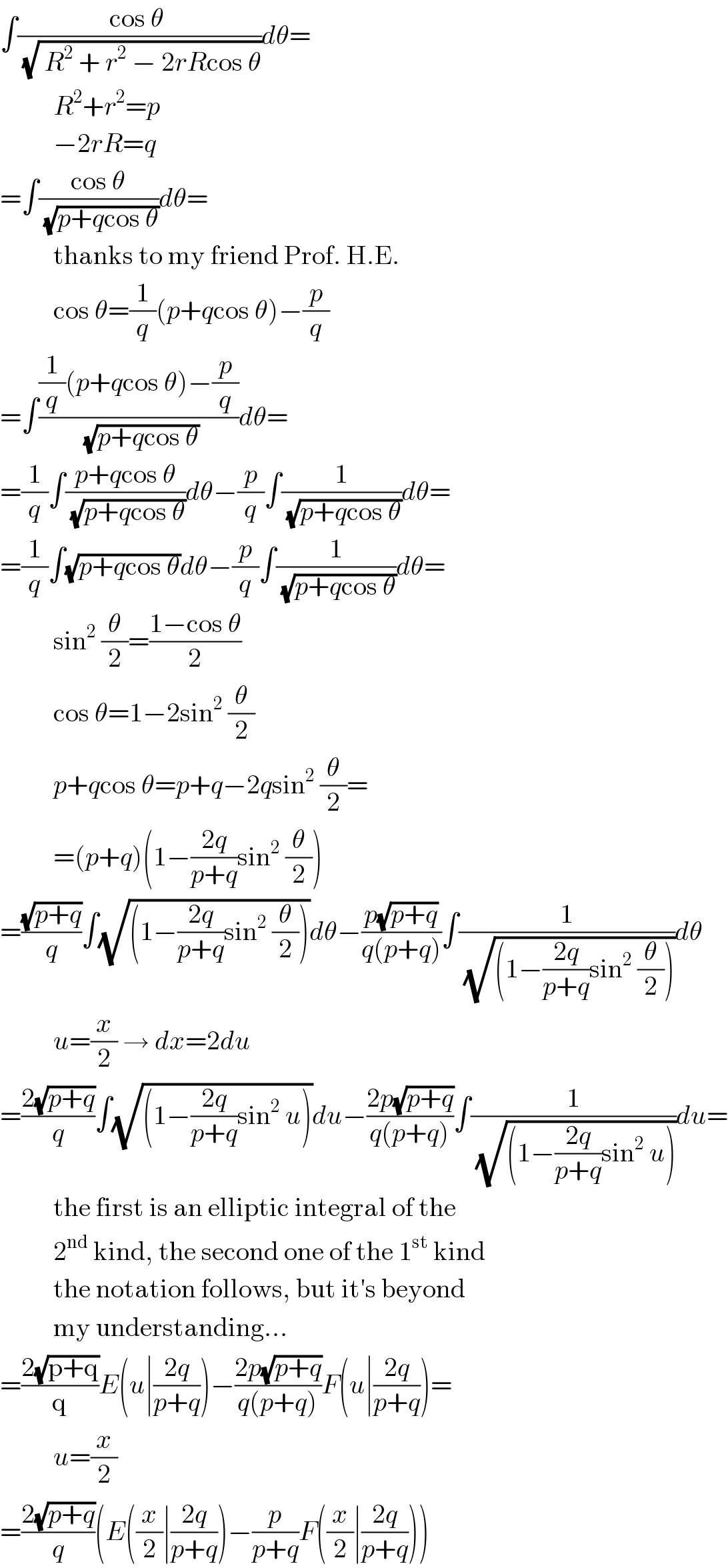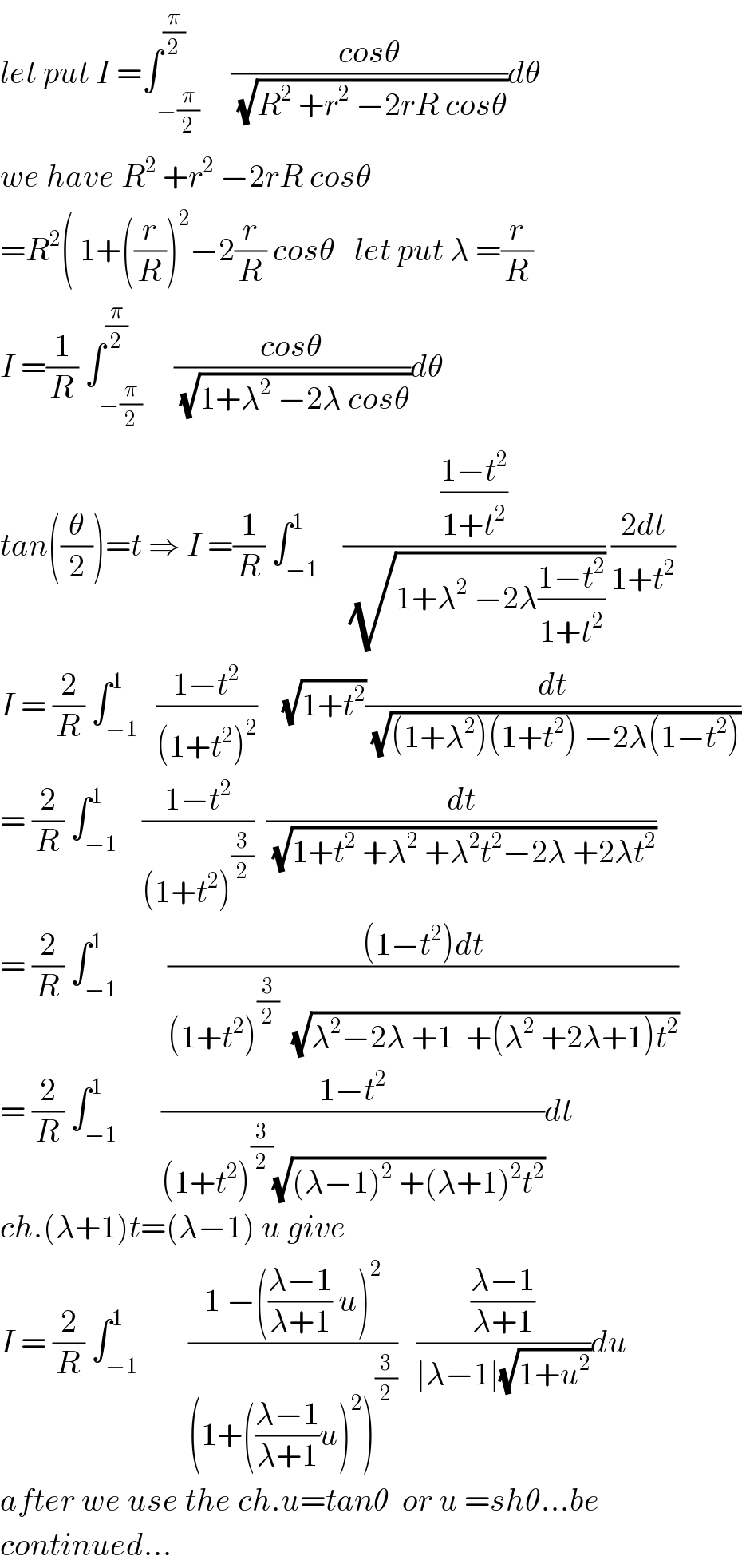
Question Number 33759 by 33 last updated on 24/Apr/18

$${solve}\::\: \\ $$$$\:\underset{−\pi/\mathrm{2}} {\overset{\pi/\mathrm{2}} {\int}}\:\:\frac{{sin}\:\theta\:}{\sqrt{\:{R}^{\mathrm{2}} \:+\:{r}^{\mathrm{2}} \:−\:\mathrm{2}{rR}\:{cos}\:\theta}}\:{d}\theta \\ $$
Commented by MJS last updated on 24/Apr/18

$$\int\frac{\mathrm{cos}\:\theta\:}{\sqrt{\:{R}^{\mathrm{2}} \:+\:{r}^{\mathrm{2}} \:−\:\mathrm{2}{rR}\mathrm{cos}\:\theta}}{d}\theta= \\ $$$$\:\:\:\:\:\:\:\:\:\:{R}^{\mathrm{2}} +{r}^{\mathrm{2}} ={p} \\ $$$$\:\:\:\:\:\:\:\:\:\:−\mathrm{2}{rR}={q} \\ $$$$=\int\frac{\mathrm{cos}\:\theta}{\sqrt{{p}+{q}\mathrm{cos}\:\theta}}{d}\theta= \\ $$$$\:\:\:\:\:\:\:\:\:\:\mathrm{thanks}\:\mathrm{to}\:\mathrm{my}\:\mathrm{friend}\:\mathrm{Prof}.\:\mathrm{H}.\mathrm{E}. \\ $$$$\:\:\:\:\:\:\:\:\:\:\mathrm{cos}\:\theta=\frac{\mathrm{1}}{{q}}\left({p}+{q}\mathrm{cos}\:\theta\right)−\frac{{p}}{{q}} \\ $$$$=\int\frac{\frac{\mathrm{1}}{{q}}\left({p}+{q}\mathrm{cos}\:\theta\right)−\frac{{p}}{{q}}}{\sqrt{{p}+{q}\mathrm{cos}\:\theta}}{d}\theta= \\ $$$$=\frac{\mathrm{1}}{{q}}\int\frac{{p}+{q}\mathrm{cos}\:\theta}{\sqrt{{p}+{q}\mathrm{cos}\:\theta}}{d}\theta−\frac{{p}}{{q}}\int\frac{\mathrm{1}}{\sqrt{{p}+{q}\mathrm{cos}\:\theta}}{d}\theta= \\ $$$$=\frac{\mathrm{1}}{{q}}\int\sqrt{{p}+{q}\mathrm{cos}\:\theta}{d}\theta−\frac{{p}}{{q}}\int\frac{\mathrm{1}}{\sqrt{{p}+{q}\mathrm{cos}\:\theta}}{d}\theta= \\ $$$$\:\:\:\:\:\:\:\:\:\:\mathrm{sin}^{\mathrm{2}} \:\frac{\theta}{\mathrm{2}}=\frac{\mathrm{1}−\mathrm{cos}\:\theta}{\mathrm{2}} \\ $$$$\:\:\:\:\:\:\:\:\:\:\mathrm{cos}\:\theta=\mathrm{1}−\mathrm{2sin}^{\mathrm{2}} \:\frac{\theta}{\mathrm{2}} \\ $$$$\:\:\:\:\:\:\:\:\:\:{p}+{q}\mathrm{cos}\:\theta={p}+{q}−\mathrm{2}{q}\mathrm{sin}^{\mathrm{2}} \:\frac{\theta}{\mathrm{2}}= \\ $$$$\:\:\:\:\:\:\:\:\:\:=\left({p}+{q}\right)\left(\mathrm{1}−\frac{\mathrm{2}{q}}{{p}+{q}}\mathrm{sin}^{\mathrm{2}} \:\frac{\theta}{\mathrm{2}}\right) \\ $$$$=\frac{\sqrt{{p}+{q}}}{{q}}\int\sqrt{\left(\mathrm{1}−\frac{\mathrm{2}{q}}{{p}+{q}}\mathrm{sin}^{\mathrm{2}} \:\frac{\theta}{\mathrm{2}}\right)}{d}\theta−\frac{{p}\sqrt{{p}+{q}}}{{q}\left({p}+{q}\right)}\int\frac{\mathrm{1}}{\sqrt{\left(\mathrm{1}−\frac{\mathrm{2}{q}}{{p}+{q}}\mathrm{sin}^{\mathrm{2}} \:\frac{\theta}{\mathrm{2}}\right)}}{d}\theta \\ $$$$\:\:\:\:\:\:\:\:\:\:{u}=\frac{{x}}{\mathrm{2}}\:\rightarrow\:{dx}=\mathrm{2}{du} \\ $$$$=\frac{\mathrm{2}\sqrt{{p}+{q}}}{{q}}\int\sqrt{\left(\mathrm{1}−\frac{\mathrm{2}{q}}{{p}+{q}}\mathrm{sin}^{\mathrm{2}} \:{u}\right)}{du}−\frac{\mathrm{2}{p}\sqrt{{p}+{q}}}{{q}\left({p}+{q}\right)}\int\frac{\mathrm{1}}{\sqrt{\left(\mathrm{1}−\frac{\mathrm{2}{q}}{{p}+{q}}\mathrm{sin}^{\mathrm{2}} \:{u}\right)}}{du}= \\ $$$$\:\:\:\:\:\:\:\:\:\:\mathrm{the}\:\mathrm{first}\:\mathrm{is}\:\mathrm{an}\:\mathrm{elliptic}\:\mathrm{integral}\:\mathrm{of}\:\mathrm{the} \\ $$$$\:\:\:\:\:\:\:\:\:\:\mathrm{2}^{\mathrm{nd}} \:\mathrm{kind},\:\mathrm{the}\:\mathrm{second}\:\mathrm{one}\:\mathrm{of}\:\mathrm{the}\:\mathrm{1}^{\mathrm{st}} \:\mathrm{kind} \\ $$$$\:\:\:\:\:\:\:\:\:\:\mathrm{the}\:\mathrm{notation}\:\mathrm{follows},\:\mathrm{but}\:\mathrm{it}'\mathrm{s}\:\mathrm{beyond} \\ $$$$\:\:\:\:\:\:\:\:\:\:\mathrm{my}\:\mathrm{understanding}... \\ $$$$=\frac{\mathrm{2}\sqrt{\mathrm{p}+\mathrm{q}}}{\mathrm{q}}{E}\left({u}\mid\frac{\mathrm{2}{q}}{{p}+{q}}\right)−\frac{\mathrm{2}{p}\sqrt{{p}+{q}}}{{q}\left({p}+{q}\right)}{F}\left({u}\mid\frac{\mathrm{2}{q}}{{p}+{q}}\right)= \\ $$$$\:\:\:\:\:\:\:\:\:\:{u}=\frac{{x}}{\mathrm{2}} \\ $$$$=\frac{\mathrm{2}\sqrt{{p}+{q}}}{{q}}\left({E}\left(\frac{{x}}{\mathrm{2}}\mid\frac{\mathrm{2}{q}}{{p}+{q}}\right)−\frac{{p}}{{p}+{q}}{F}\left(\frac{{x}}{\mathrm{2}}\mid\frac{\mathrm{2}{q}}{{p}+{q}}\right)\right) \\ $$
Commented by prof Abdo imad last updated on 24/Apr/18

$${let}\:{put}\:{I}\:=\int_{−\frac{\pi}{\mathrm{2}}} ^{\frac{\pi}{\mathrm{2}}} \:\:\:\:\frac{{cos}\theta}{\sqrt{{R}^{\mathrm{2}} \:+{r}^{\mathrm{2}} \:−\mathrm{2}{rR}\:{cos}\theta}}{d}\theta \\ $$$${we}\:{have}\:{R}^{\mathrm{2}} \:+{r}^{\mathrm{2}} \:−\mathrm{2}{rR}\:{cos}\theta \\ $$$$={R}^{\mathrm{2}} \left(\:\mathrm{1}+\left(\frac{{r}}{{R}}\right)^{\mathrm{2}} −\mathrm{2}\frac{{r}}{{R}}\:{cos}\theta\:\:\:{let}\:{put}\:\lambda\:=\frac{{r}}{{R}}\right. \\ $$$${I}\:=\frac{\mathrm{1}}{{R}}\:\int_{−\frac{\pi}{\mathrm{2}}} ^{\frac{\pi}{\mathrm{2}}} \:\:\:\:\frac{{cos}\theta}{\sqrt{\mathrm{1}+\lambda^{\mathrm{2}} \:−\mathrm{2}\lambda\:{cos}\theta}}{d}\theta \\ $$$${tan}\left(\frac{\theta}{\mathrm{2}}\right)={t}\:\Rightarrow\:{I}\:=\frac{\mathrm{1}}{{R}}\:\int_{−\mathrm{1}} ^{\mathrm{1}} \:\:\:\frac{\frac{\mathrm{1}−{t}^{\mathrm{2}} }{\mathrm{1}+{t}^{\mathrm{2}} }}{\sqrt{\mathrm{1}+\lambda^{\mathrm{2}} \:−\mathrm{2}\lambda\frac{\mathrm{1}−{t}^{\mathrm{2}} }{\mathrm{1}+{t}^{\mathrm{2}} }}}\:\frac{\mathrm{2}{dt}}{\mathrm{1}+{t}^{\mathrm{2}} } \\ $$$${I}\:=\:\frac{\mathrm{2}}{{R}}\:\int_{−\mathrm{1}} ^{\mathrm{1}} \:\:\frac{\mathrm{1}−{t}^{\mathrm{2}} }{\left(\mathrm{1}+{t}^{\mathrm{2}} \right)^{\mathrm{2}} }\:\:\:\:\sqrt{\mathrm{1}+{t}^{\mathrm{2}} }\frac{{dt}}{\sqrt{\left(\mathrm{1}+\lambda^{\mathrm{2}} \right)\left(\mathrm{1}+{t}^{\mathrm{2}} \right)\:−\mathrm{2}\lambda\left(\mathrm{1}−{t}^{\mathrm{2}} \right)}} \\ $$$$=\:\frac{\mathrm{2}}{{R}}\:\int_{−\mathrm{1}} ^{\mathrm{1}} \:\:\:\frac{\mathrm{1}−{t}^{\mathrm{2}} }{\left(\mathrm{1}+{t}^{\mathrm{2}} \right)^{\frac{\mathrm{3}}{\mathrm{2}}} }\:\:\frac{{dt}}{\sqrt{\mathrm{1}+{t}^{\mathrm{2}} \:+\lambda^{\mathrm{2}} \:+\lambda^{\mathrm{2}} {t}^{\mathrm{2}} −\mathrm{2}\lambda\:+\mathrm{2}\lambda{t}^{\mathrm{2}} }} \\ $$$$=\:\frac{\mathrm{2}}{{R}}\:\int_{−\mathrm{1}} ^{\mathrm{1}} \:\:\:\:\:\:\:\frac{\left(\mathrm{1}−{t}^{\mathrm{2}} \right){dt}}{\left(\mathrm{1}+{t}^{\mathrm{2}} \right)^{\frac{\mathrm{3}}{\mathrm{2}}} \:\:\sqrt{\lambda^{\mathrm{2}} −\mathrm{2}\lambda\:+\mathrm{1}\:\:+\left(\lambda^{\mathrm{2}} \:+\mathrm{2}\lambda+\mathrm{1}\right){t}^{\mathrm{2}} }} \\ $$$$=\:\frac{\mathrm{2}}{{R}}\:\int_{−\mathrm{1}} ^{\mathrm{1}} \:\:\:\:\:\:\frac{\mathrm{1}−{t}^{\mathrm{2}} }{\left(\mathrm{1}+{t}^{\mathrm{2}} \right)^{\frac{\mathrm{3}}{\mathrm{2}}} \sqrt{\left(\lambda−\mathrm{1}\right)^{\mathrm{2}} \:+\left(\lambda+\mathrm{1}\right)^{\mathrm{2}} {t}^{\mathrm{2}} }}{dt} \\ $$$${ch}.\left(\lambda+\mathrm{1}\right){t}=\left(\lambda−\mathrm{1}\right)\:{u}\:{give} \\ $$$${I}\:=\:\frac{\mathrm{2}}{{R}}\:\int_{−\mathrm{1}} ^{\mathrm{1}} \:\:\:\:\:\:\:\frac{\mathrm{1}\:−\left(\frac{\lambda−\mathrm{1}}{\lambda+\mathrm{1}}\:{u}\right)^{\mathrm{2}} }{\left(\mathrm{1}+\left(\frac{\lambda−\mathrm{1}}{\lambda+\mathrm{1}}{u}\right)^{\mathrm{2}} \right)^{\frac{\mathrm{3}}{\mathrm{2}}} }\:\:\:\frac{\frac{\lambda−\mathrm{1}}{\lambda+\mathrm{1}}}{\mid\lambda−\mathrm{1}\mid\sqrt{\mathrm{1}+{u}^{\mathrm{2}} }}{du} \\ $$$${after}\:{we}\:{use}\:{the}\:{ch}.{u}={tan}\theta\:\:{or}\:{u}\:={sh}\theta...{be} \\ $$$${continued}... \\ $$
Commented by 33 last updated on 24/Apr/18

$${To}\:{sir}\:{MJS}\:,\:{sir}\:{we}\:{cannot} \\ $$$${consider}\:{a},\:{b}\:{and}\:{c}\:\:\:{as}\: \\ $$$${constants}\:{as}\:{they}\:{are}\: \\ $$$${dependent}\:{on}\:{cos}\:\theta\:. \\ $$$${and}\:{you}\:{do}\:{not}\:{know} \\ $$$${a}\:{b}\:{c}\:\:\:{as}\:{a}\:{function}\:{of}\:\alpha\: \\ $$$${and}\:{vice}\:{versa}. \\ $$
Commented by MJS last updated on 24/Apr/18

$$\mathrm{you}'\mathrm{re}\:\mathrm{right} \\ $$
Commented by MJS last updated on 24/Apr/18

$$...\mathrm{this}\:\mathrm{leads}\:\mathrm{to}\:\mathrm{an}\:\mathrm{elliptic}\:\mathrm{integral}\:\mathrm{and}\:\mathrm{it} \\ $$$$\mathrm{might}\:\mathrm{be}\:\mathrm{impossible}\:\mathrm{to}\:\mathrm{exactly}\:\mathrm{solve}\:\mathrm{it} \\ $$
Commented by 33 last updated on 24/Apr/18

$${what}\:{if}\:{there}\:{were}\:{sine}\: \\ $$$${instead}\:{of}\:{cos}\:{in}\:{numerator}? \\ $$
Commented by MJS last updated on 24/Apr/18

$$\mathrm{then}\:\mathrm{it}'\mathrm{s}\:\mathrm{easy} \\ $$$$\int\frac{\mathrm{cos}\:\theta}{\sqrt{{R}^{\mathrm{2}} +{r}^{\mathrm{2}} −\mathrm{2}{Rr}\mathrm{sin}\:\theta}}{d}\theta= \\ $$$$\:\:\:\:\:\:\:\:\:\:{u}={R}^{\mathrm{2}} +{r}^{\mathrm{2}} −\mathrm{2}{Rr}\mathrm{sin}\:\theta \\ $$$$\:\:\:\:\:\:\:\:\:\:{dx}=−\frac{\mathrm{1}}{\mathrm{2}{rR}\mathrm{cos}\:\theta} \\ $$$$−\frac{\mathrm{1}}{\mathrm{2}{rR}}\int\frac{\mathrm{1}}{\sqrt{{u}}}{du}=−\frac{\mathrm{1}}{\mathrm{2}{rR}}×\mathrm{2}\sqrt{{u}}+{C}=−\frac{\sqrt{{u}}}{{rR}}+{C}= \\ $$$$=−\frac{\sqrt{{R}^{\mathrm{2}} +{r}^{\mathrm{2}} −\mathrm{2}{Rr}\mathrm{sin}\:\theta}}{{rR}}+{C} \\ $$$$\underset{−\frac{\pi}{\mathrm{2}}} {\overset{\frac{\pi}{\mathrm{2}}} {\int}}\frac{\mathrm{cos}\:\theta}{\sqrt{{R}^{\mathrm{2}} +{r}^{\mathrm{2}} −\mathrm{2}{Rr}\mathrm{sin}\:\theta}}{d}\theta= \\ $$$$=\frac{\sqrt{{R}^{\mathrm{2}} +{r}^{\mathrm{2}} +\mathrm{2}{rR}}−\sqrt{{R}^{\mathrm{2}} +{r}^{\mathrm{2}} −\mathrm{2}{rR}}}{{rR}}= \\ $$$$=\frac{\sqrt{\left({R}+{r}\right)^{\mathrm{2}} }−\sqrt{\left({R}−{r}\right)^{\mathrm{2}} }}{{rR}}= \\ $$$$=\frac{\mid{R}+{r}\mid−\mid{R}−{r}\mid}{{rR}}= \\ $$$$\:\:\:\:\:\:\:\:\:\:\mathrm{if}\:{R}>{r}\:\wedge\:{R}>\mathrm{0}\:\wedge\:{r}>\mathrm{0} \\ $$$$=\frac{{R}+{r}−\left({R}−{r}\right)}{{rR}}=\frac{\mathrm{2}}{{R}} \\ $$
Commented by MJS last updated on 24/Apr/18

$$\mathrm{sorry},\:\mathrm{I}\:\mathrm{misread}...\:\mathrm{but}\:\mathrm{it}'\mathrm{s}\:\mathrm{the}\:\mathrm{same}\:\mathrm{way}: \\ $$$$\int\frac{\mathrm{sin}\:\theta}{\sqrt{{R}^{\mathrm{2}} +{r}^{\mathrm{2}} −\mathrm{2}{Rr}\mathrm{cos}\:\theta}}{d}\theta= \\ $$$$=\frac{\sqrt{{R}^{\mathrm{2}} +{r}^{\mathrm{2}} −\mathrm{2}{Rr}\mathrm{cos}\:\theta}}{{rR}}+{C} \\ $$$$\underset{−\frac{\pi}{\mathrm{2}}} {\overset{\frac{\pi}{\mathrm{2}}} {\int}}\frac{\mathrm{sin}\:\theta}{\sqrt{{R}^{\mathrm{2}} +{r}^{\mathrm{2}} −\mathrm{2}{Rr}\mathrm{cos}\:\theta}}{d}\theta=\mathrm{0} \\ $$
Commented by prof Abdo imad last updated on 25/Apr/18

$${something}\:{went}\:{wrong}\:{becsuse}\:\theta\rightarrow\frac{{sin}\theta}{\sqrt{{R}^{\mathrm{2}} \:+{r}^{\mathrm{2}} \:−\mathrm{2}{rR}\:{cos}\theta}} \\ $$$${is}\:{odd}\:\:\Rightarrow\int_{−\frac{\pi}{\mathrm{2}}} ^{\frac{\pi}{\mathrm{2}}} \:\left(...\right){d}\theta\:=\mathrm{0} \\ $$
